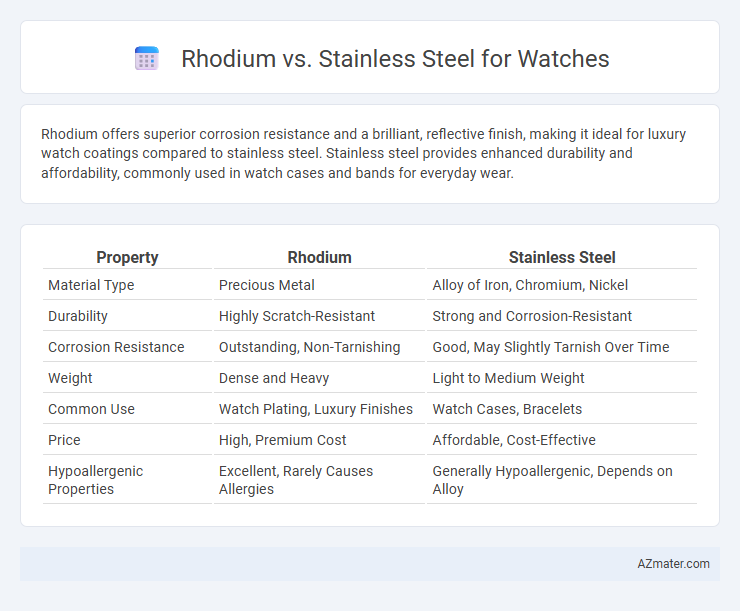Rhodium offers superior corrosion resistance and a brilliant, reflective finish, making it ideal for luxury watch coatings compared to stainless steel. Stainless steel provides enhanced durability and affordability, commonly used in watch cases and bands for everyday wear.
Table of Comparison
| Property | Rhodium | Stainless Steel |
|---|---|---|
| Material Type | Precious Metal | Alloy of Iron, Chromium, Nickel |
| Durability | Highly Scratch-Resistant | Strong and Corrosion-Resistant |
| Corrosion Resistance | Outstanding, Non-Tarnishing | Good, May Slightly Tarnish Over Time |
| Weight | Dense and Heavy | Light to Medium Weight |
| Common Use | Watch Plating, Luxury Finishes | Watch Cases, Bracelets |
| Price | High, Premium Cost | Affordable, Cost-Effective |
| Hypoallergenic Properties | Excellent, Rarely Causes Allergies | Generally Hypoallergenic, Depends on Alloy |
Introduction to Rhodium and Stainless Steel in Watchmaking
Rhodium is a rare, silver-white metal known for its exceptional hardness, corrosion resistance, and brilliant reflective finish, making it a prized plating material in luxury watchmaking. Stainless steel, an alloy primarily composed of iron, carbon, and chromium, offers outstanding durability, resistance to rust and tarnish, and a sleek, modern appearance favored in both premium and everyday watches. The choice between rhodium plating and stainless steel depends on factors such as desired aesthetics, wear resistance, and maintenance considerations in timepiece design.
Composition and Properties of Rhodium
Rhodium, a rare and lustrous platinum-group metal, is highly valued for its exceptional hardness, corrosion resistance, and brilliant reflective surface, making it an ideal plating material for watches. Unlike stainless steel, which primarily consists of iron, chromium, and nickel, rhodium's pure elemental composition provides superior resistance to tarnishing and scratches. The use of rhodium plating on watch cases and bracelets enhances durability and maintains a long-lasting, bright finish compared to the naturally resilient but bulkier stainless steel.
Characteristics of Stainless Steel for Watches
Stainless steel is highly favored in watchmaking due to its exceptional corrosion resistance, durability, and hypoallergenic properties, making it suitable for everyday wear and various environmental conditions. Its ability to maintain a polished finish without tarnishing enhances the watch's aesthetic appeal over time. The material's strength combined with its affordability makes stainless steel a versatile and practical choice compared to rhodium plating, which is typically used as a decorative finish rather than the base material.
Aesthetic Differences: Appearance and Finishes
Rhodium offers a brilliant, reflective white finish that enhances a watch's elegance with a lustrous, mirror-like sheen, often used as a plating for added luxury and durability. Stainless steel features a more subdued, matte to polished finish with a modern, industrial appeal, prized for its resilience and resistance to corrosion and scratches. The choice between rhodium and stainless steel significantly influences the watch's visual impact, balancing high-shine sophistication against practical everyday wearability.
Durability and Scratch Resistance Comparison
Rhodium plating offers excellent scratch resistance and corrosion protection, making it highly durable for watch surfaces, though it may wear off over time requiring re-plating. Stainless steel features superior overall durability with inherent resistance to scratches, dents, and everyday wear due to its robust alloy composition. For long-term resilience, stainless steel maintains structural integrity better, while rhodium excels in preserving shiny, scratch-resistant finishes but demands periodic maintenance.
Hypoallergenic Qualities and Skin Compatibility
Rhodium plating on watches offers superior hypoallergenic qualities, minimizing the risk of skin irritation and allergic reactions compared to stainless steel, which may contain nickel, a common allergen. Stainless steel, particularly surgical-grade 316L or 904L, is widely appreciated for its durability and moderate hypoallergenic properties but can still cause sensitivity in people with nickel allergies. Rhodium's non-reactive, inert surface ensures enhanced skin compatibility, making it an ideal choice for individuals with sensitive skin or metal sensitivities.
Cost Analysis: Rhodium vs Stainless Steel
Rhodium plating significantly increases the cost of watches compared to stainless steel due to the precious metal's rarity and complex application process. Stainless steel offers a more economical option with durability and corrosion resistance, making it popular for affordable to mid-range watches. High-end timepieces that feature rhodium are priced premium, reflecting the metal's lustrous finish and enhanced scratch resistance.
Maintenance and Care Requirements
Rhodium-plated watches require periodic re-plating to maintain their lustrous finish and prevent tarnishing, while stainless steel watches resist corrosion and require minimal upkeep. Stainless steel can withstand everyday exposure to sweat, water, and chemicals with simple cleaning using mild soap and water. Both materials benefit from avoiding abrasive cleaners and storing watches in dry conditions to prolong their longevity.
Environmental Impact and Sustainability
Rhodium plating on watches offers superior corrosion resistance and a reflective finish but relies on mining a rare and environmentally taxing precious metal, raising concerns about resource depletion and ecological disruption. Stainless steel is highly durable, recyclable, and widely used in watchmaking, with production processes increasingly adopting sustainable practices to reduce carbon emissions and waste. Choosing stainless steel over rhodium-plated materials generally supports better sustainability through recyclability and lower environmental impact during extraction and manufacturing.
Choosing the Right Material for Your Watch
Rhodium offers a brilliant, corrosion-resistant finish that enhances a watch's aesthetic appeal and durability, making it ideal for luxury timepieces requiring long-lasting shine. Stainless steel provides superior strength, scratch resistance, and affordability, making it a practical choice for everyday wear watches with reliable performance. Selecting between rhodium and stainless steel depends on your preference for luxury finish versus durability and cost-effectiveness in watch materials.

Infographic: Rhodium vs Stainless Steel for Watch
 azmater.com
azmater.com